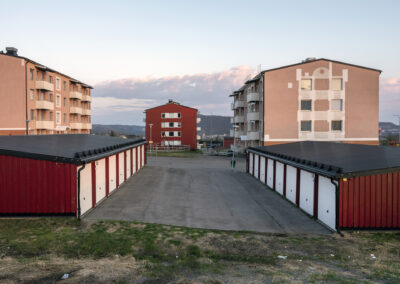
SOUTH OF NO NORTH
Max Sher
maxsher.com
These images are a result of an outsider’s photographic exploration of three towns in northern Sweden—Luleå, Kiruna, and Jokkmokk, or their built environment, to be precise. Focusing on its everyday aspects I attempted to make a small step towards ‘de-idyllizing’ the visual representation of Sweden’s northernmost province. Often—and for a reason—portrayed as a sanctuary of pristine forests and pure lakes, its other face—the one of a treasure trove of the Swedish extraction industry—tends to remain obscure. The photographs, however, do not straightforwardly depict the mining or steel industries as such but rather the urban milieu that appears to be one of their (by-)products.
Interestingly, the long-established political-economic division of the world into the so-called developing ‘Global South’ and the developed ‘Global North’—the former still largely acting as a resource base for the latter, often as a result of previous colonial seizures—might come into question in the mining regions of the global North itself. Sweden is a bright example. Its northern territories—a part of Sápmi, home of the indigenous Sami people, still rather known by its old colonial name Lapland—appear to be acting and unconsciously perceived as Sweden’s own internal colony, a ‘South’ within the ‘North’. The mining industry creates a distinctively top-down political economy, and the city of Kiruna is reminiscent of many similar company towns located in the ‘Global South’ or in the resource-rich peripheries of the ‘Global North’.
In the western (‘Northern’) imagination, the colonial frontiers, the remote ‘southern’ riches always went hand in hand with exoticization and idyllization. Exoticized imagery of a wild frontier and idyllized depictions of acquired and developed lands acted as imaginary screens concealing the social and economic realities or, worse, stimulating further conquests and justifications thereof. This helped construct narratives of expansion, ‘development’, putting uncivilized ‘wild’ areas to ‘good use’, portraying indigenous nations as backward and necessitating ‘modernization’. In effect, it most often meant land grabs for mining in exchange for promises of jobs, infrastructure, and ‘civilization’.
The dominating image of the Swedish North as a depoliticized picture-postcard land of idyllic untapped wilderness and exotic reindeer herders appears to contribute to the reproduction of such colonial attitudes and to obscure the real power struggles, material tensions and political relations characteristic of the region. It is my conviction that by focusing on everyday spaces and landscapes of the ordinary, photography, though unable to actually visualize it, can at least provide an alternative ‘vantage point’ for making sense of and questioning the current political order anywhere.


































